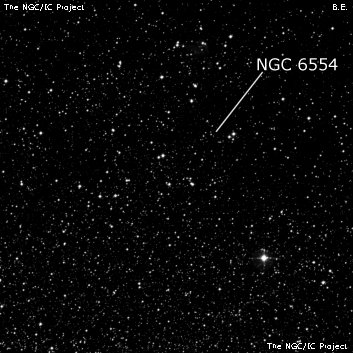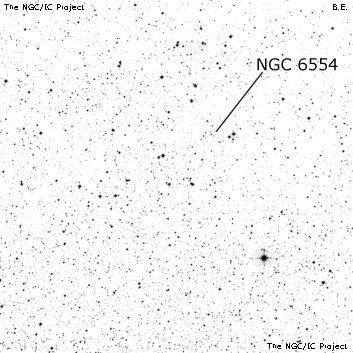NGC/IC Project Restoration Effort
(This is a very very beta version)
NGC6554


Basic Information
Location and Magnitude
Right Ascension: 18:9:23.0
Declination: -18:22:42
Constellation: SGR
Visual Magnitude:
Historic Information
Discoverer: Herschel J.
Year of discovery: 1830
Discovery aperture: 18.3
Observational
Summary description: Cl, pRi, vlC, st L ___DREYER___ S
Sub-type: *Grp
Corwin's Notes
=====
NGC 6554. During the plate scanning for ESGC, I noted this as "20-30 stars in
a 20 arcmin area." I don't believe that these stars are a real cluster, but
they do stand out from the field enough that they could be picked up during a
visual sweep. JH's comment "Has several double stars in it" also makes it
clear that he was seeing the same concentration of stars. I put the center
somewhat east-northeast of JH's position, but the identity is not in question.
Looking at this again in January 2016 on the DSS2 red image, I see some
nebulosity -- brightest on the northwest boundary -- associated with the
stars. This suggests that this is a real cluster, after all. Detailed
studies are in order.
Steve's Notes
=====
NGC 6554
18" (9/3/05): at 115x appears as a large, scattered group of ~100 stars in a 25' x10' region. Most of the brighter stars form a triangular outline with a 15' string of stars oriented NW to SE forming the western leg of the triangle being most evident. A number of faint stars pepper the interior at 225x, though at this power the group filled the field and was not recognizable at all. This appears to be a random Milky Way asterism although the triangular outline is somewhat detached in the field at low power. Contains a number of mag 10.5-11.5 star although there is no single brighter star. A fairly small triangle of stars including a mag 11 pair at 27" is off the west side.
17.5" (8/12/01): large, very scattered, elongated group at 100x. Roughly three dozen stars are visible in an arbitrary 20'x6' region, extended NW-SE. A close quadruple is at the west side of the NW end. There are no rich concentrations and the group looks just like an random asterism. At 220x, ~50 stars are seen with some faint clumps visible but as the group now fills the field I would not have noticed it at all at this power. The outline is easier to trace along the western flank and around the NW end. An evenly matched mag 12 pair is off the west side but is not within the main group. Listed as a nonexistent cluster in the RNGC.



